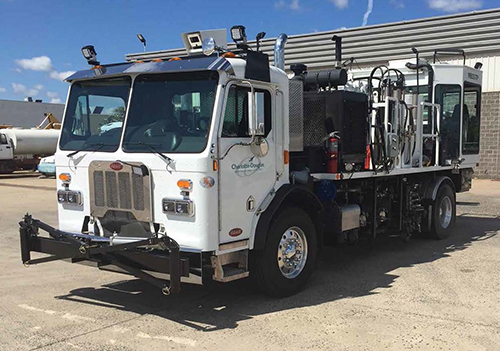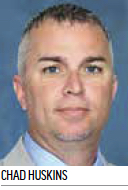Charlotte Douglas Int'l Boosts Airfield Maintenance Program

Charlotte Douglas International (CLT) has invested heavily in its airfield maintenance program over the past several years. From airfield markings and lighting to snow removal, landscape operations and wildlife management, the North Carolina airport has committed time and resources to its comprehensive effort.
What's driving all of the initiatives? Ensuring the safety and security of nearly 45 million passengers, explains CLT Field Maintenance Manager Chad Huskins. "First and foremost, we want to make sure we're operating a safe airfield," he emphasizes. "Having the proper equipment and highly trained staff who know what they are looking for when they get out on the airfield is critical to achieving that goal."
Education & Equipment
Airport officials have made a concerted effort to take a proactive, rather than reactive, approach to airfield maintenance, informs Huskins. "The FAA regularly sends inspectors to conferences for training on what to look for when inspecting airfields. Here at CLT, we have taken the initiative to make sure our folks are as well trained as FAA inspectors in airfield maintenance issues. We want to be on the cutting edge."
 FACTS&FIGURES FACTS&FIGURESProject: Airfield Maintenance Program Location: Charlotte Douglas (NC) Int'l Airport Approx. Equipment Costs: $4.2 million Audit & Training Costs: $74,300 Funding: Capital improvement program; passenger facility charges Airfield Markings Consultant: Sightline Rubber & Paint Removal: Stripe Hog SH8000 (Waterblasting Technologies) Paint Striping: M-B 357 Paint Truck (M-B Companies) Surface Pressure Washer: Cyclone CY5500 (Nilfisk Cyclone-Team Eagle) Friction Tester: Skiddometer BV11 Friction Tester (Fortbrand) Mowing Equipment: Jacobsen HR 9016T Snow Removal Vehicles: Vammas (Fortbrand) Rotary Plow/Snowblower: North Star (M-B Equipment) Runway Deicer: Tyler Deicer (Wausau Equipment) Strategy: Invest in maintenance equipment & staff training to achieve best practices in all areas of airfield maintenance |
Several years ago, for instance, CLT maintenance staff attended a conference that included a session with detailed information on how to evaluate and analyze airfield paint markings. Afterward, the airport hired Sightline, the company that presented the information, to conduct an audit of its airfield markings. Trainers from the company also taught airport staff how to evaluate paint markings and how to measure bead application for proper reflectivity.
Sightline Vice President Mike Speidel praises the general evolution of CLT's airfield maintenance program, and its markings program in particular. "A lot of airports take a reactionary approach to airfield markings. That is, they typically paint as much as they can prior to an imminent FAA inspection and then react to the inspector's comments. But in many instances, when airports take a reactionary approach, it's like putting lipstick on a pig. After the inspector leaves, the airport returns to its earlier behaviors."
The audit and subsequent training from Sightline complements other investments the airport had been making in airfield marking equipment. "We were investing in new equipment and methods of operation," notes Huskins. "We made a major investment in paint and rubber removal equipment and purchased our own friction testing equipment, a task that previously had been contracted out."
The airport purchased a Stripe Hog SH8000 rubber and paint removal machine and switched from using palletized striper that attaches to a pickup truck to a full-size M-B 357 Paint Striper truck. To clean the ramp and apron areas, CLT added a Nilfisk Cyclone CY5500 surface cleaner pressure washer, which recycles the water it uses and collects surface material.
Prior to purchasing a water-blasting system, the airport removed rubber from its airfield pavements with a chemical peel method that required four employees. Paint removal, however, was performed by an outside contractor, and scheduling the work had proved problematic, notes Airfield Marking Supervisor Michael Fabbiano.
By purchasing new equipment and handling paint removal in-house, the airport saved $447,000 in outside contractor fees from July 2015, when CLT's new Stripe Hog unit went into operation, to this July.
The goal, Speidel explains, is to paint less and clean more. In order to clean markings rather than paint new ones, however, markings need to be applied correctly. If markings are applied properly, he elaborates, maintenance staff can use a water blaster to clean them multiple times before they need to be painted again. That's how airports save money, he stresses.
All told, CLT invested nearly $1 million in equipment for airfield paint operations, reports Huskins. "Not only does it save significant dollars, it also gives us huge flexibility in performing our work," he adds.
Many Moving Parts
CLT has taken a broad-brush approach to expanding and improving its airfield maintenance operations. The airport purchased three used Vammas snow removal vehicles and recently added a fourth new unit. According to airport staff, the equipment has reduced snow-clearing time from 45 minutes to 15 minutes per runway. Crews use a new M-B North Star snow blower to safely remove windrows, and a new 4,000-gallon Tyler Deicer with 75-foot booms keeps runways operational during occasional inclement weather events.
When the snow melts and grass starts growing again, CLT's new high-end mowers kick into gear. The airport, in fact, recently tested new equipment for the Charlotte branch of Jacobsen, a mower manufacturing company.
 "Our old mowers were big, hard-to-maneuver tractors with pull-behind decks," Huskins recalls. "The operator would have to constantly look back to make sure he didn't damage light fixtures. The new mowers have everything to the front and sides of the operator. The operator can raise the deck on either side."
"Our old mowers were big, hard-to-maneuver tractors with pull-behind decks," Huskins recalls. "The operator would have to constantly look back to make sure he didn't damage light fixtures. The new mowers have everything to the front and sides of the operator. The operator can raise the deck on either side."
To prevent runway incursions from wildlife, CLT reduced bird and animal habitats by mulching 30 acres of airside land. Plantings feature vegetation that is decidedly unattractive to birds. The airport's landscape master plan, in coordination with its wildlife management plan, avoids invasive species in favor of drought-tolerant native species.
Currently, CLT is in the process of converting taxiway and runway lighting to LED fixtures. This past year, the airport converted all ramp and cargo ramp areas to LED, which is saving the airport $82,000 annually, Huskins informs.
 Team Effort
Team Effort
Developing and maintaining a top-notch airfield maintenance program requires communication, coordination and cooperation among various departments and players at the airport, Huskins advises.
"It's a team effort," he emphasizes. "That includes development and engineering staff as well as operations and field maintenance staff. And, of course, we need the support of upper management to provide us with the necessary manpower and tools."
Since last year, CLT has added 13 people to its Field Maintenance Department, growing it from 38 to 51 employees.
"I like to think of Charlotte as a great team that just keeps coming together year after year to get the job done," Huskins enthusiastically summarizes. "That's what makes us successful. Everyone has a strong desire to make CLT the best airport in the industry."

FREE Whitepaper
Fairbanks International Airport Baggage Transport Conveyor Enhanced With Mod Drive™ System
Airports face a host of unique industry challenges, such as meeting efficiency regulations and seeking out the best maintenance practices to reduce costs and keep operations flowing. In today’s current economic climate, any potential cost savings can go a long way.
In 2019, Alaska’s Fairbanks International Airport (FAI) sought to modernize its equipment and operations. They were dissatisfied with the performance of the gearmotors on their baggage transport conveyors and began searching for new suppliers. Regal approached FAI with a solution that could improve equipment performance and simplify maintenance, with the added benefit of energy cost savings: the Hub City® MOD Drive™ system.
This white paper discusses the hardware deployed, the test results and the annualized expectations for ROI.








